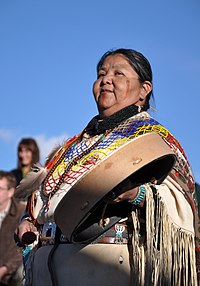
Back Хавасупаи Bulgarian Havasupais Catalan Havasupai-indianere Danish Havasupai German Havasupai Spanish Havasupai French Havasúpaigh Irish הוואסופאי HE Havasupai Indijanci Croatian Havasupai Italian
This article includes a list of general references, but it lacks sufficient corresponding inline citations. (May 2013) |
Havasupai–Hualapai: Havsuwʼ Baaja | |
|---|---|
 A Havasupai woman in ceremonial attire, 2010 | |
| Total population | |
| About 730 (2017) | |
| Regions with significant populations | |
| Supai, Arizona | |
| Languages | |
| Havasupai, English | |
| Religion | |
| Indigenous, Christianity | |
| Related ethnic groups | |
| Yavapai, Hualapai |

The Havasupai people (Havasupai: Havsuw' Baaja) are a Native American people and tribe who have lived in the Grand Canyon for at least the past 800 years.[1] Hava means "blue sky," (or just 'sky'), "su" means "water," and pai "people".[2] Another way to consider the Havasupai people is to call them 'the people of the blue and green sky and water.'
Located primarily in an area known as Havasu Canyon,[3] this Yuman-speaking population once laid claim to an area the size of Delaware (1.6×106 acres [6,500 km2]).[4] In 1882, however, the United States federal government forced the tribe to abandon all but 518 acres (210 ha) of its land. A silver rush and the Santa Fe Railroad in effect destroyed the fertile land. Furthermore, the inception of the Grand Canyon as a national park in 1919 pushed the Havasupai to the brink, as their land was consistently being used by the National Park Service. Throughout the 20th century, the tribe used the US judicial system to fight for the restoration of the land. In 1975, the tribe succeeded in regaining approximately 185,000 acres (75,000 ha) of their ancestral land with the passage of the Grand Canyon National Park Enlargement Act.[5]
As a means of survival, the tribe has turned to tourism, attracting thousands of people annually to its streams and waterfalls at the Havasupai Indian Reservation.
- ^ Gerke, Sarah Bohl; Hirt, Paul. "Havasupai Reservation". Nature, Culture, and History at the Grand Canyon. Arizona State University. Archived from the original on 2017-08-08.
- ^ Bureau of Indian Affairs (1928). The Havasupai Indian Agency, Arizona. Haskell Printing Department. p. 6.
- ^ National Park Service. "Havasupai Indian Reservation". Archived from the original on Jan 27, 2024.
- ^ Whiting, A. F. (1985). Weber, Steven A.; Seaman, P. David (eds.). Havasupai Habitat. Tucson, Arizona: University of Arizona Press. ISBN 978-0-8165-4119-5.
- ^ United States Statutes at Large 1974, Volume 88 (PDF), Washington: United States Government Printing Office, 1976, p. 2089, retrieved 2013-05-05